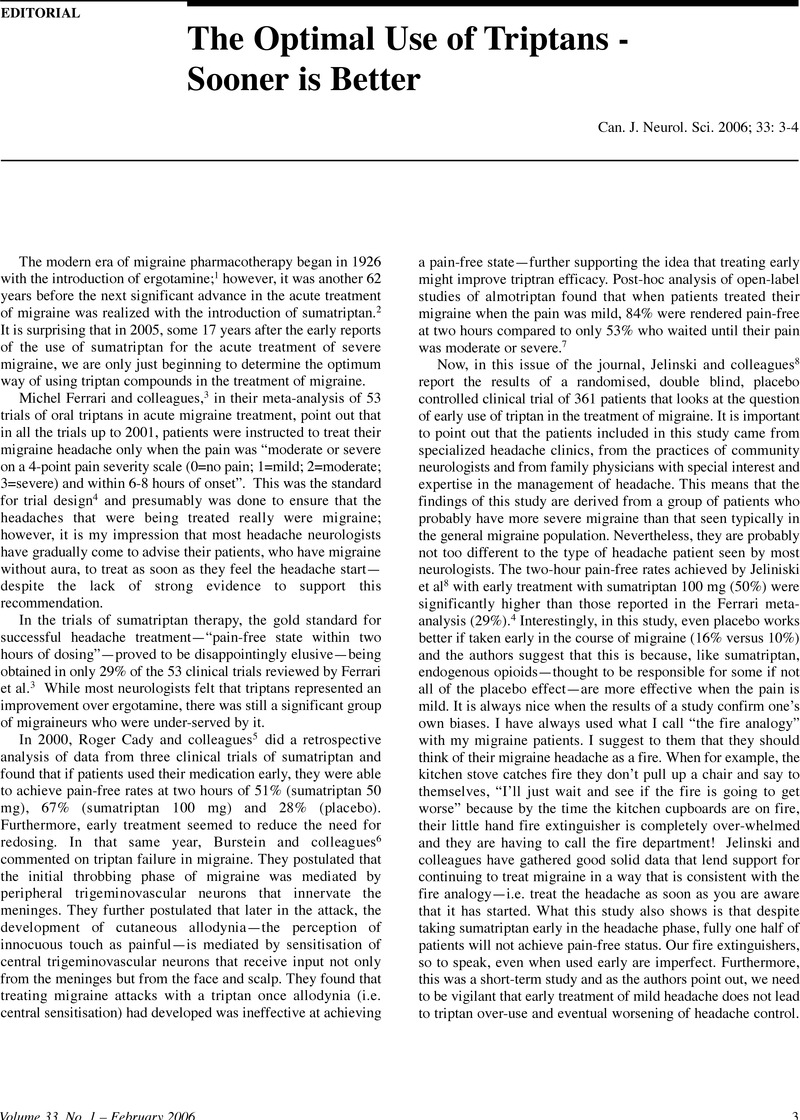No CrossRef data available.
Article contents
The Optimal Use of Triptans - Sooner is Better
Published online by Cambridge University Press: 02 December 2014
Abstract
An abstract is not available for this content so a preview has been provided. As you have access to this content, a full PDF is available via the ‘Save PDF’ action button.

- Type
- Editorial
- Information
- Copyright
- Copyright © The Canadian Journal of Neurological 2006
References
1.
Maier, HW. L’ergotamine inhibitteur du sympathique étudie enclinique, comme moyen d’exploration et comme agent therapeutique. Rev Neurol. 1926;33:1104–08.Google Scholar
2.
Doenicke, A, Brand, J, Perrin, VL. Possible benefit of GR43175, anovel 5-HT1-like receptor agonist, for the acute treatment of severe migraine. The Lancet. 1988;11:1309–11.CrossRefGoogle Scholar
3.
Ferrari, MD, Roon, KI, Lipton, RB, et al.
Oral tripans (Serotonin 5-HT1B/1D agonists) in acute migraine treatment: a meta-analysis of 53 trials. The Lancet. 2001;358:1668–75.CrossRefGoogle Scholar
4.
Pilgrim, AJ. Methodology of clinical trials of sumatriptan inmigraine and cluster headache. Eur Neurol. 1991;31:295–9.CrossRefGoogle ScholarPubMed
5.
Cady, RK, Sheftell, F, Lipton, RB, et al.
Effect of early intervention with sumatriptan on migraine pain: retrospective analyses of data from three clinical trials. Clin Ther. 2000;22:1035–48.CrossRefGoogle ScholarPubMed
6.
Burstein, R, Collins, B, Jakubowski, M. Defeating migraine pain withtriptans: a race against the development of cutaneous allodynia. Ann Neurol. 2004;55:19–26.CrossRefGoogle ScholarPubMed
7.
Pascual, J. Clinical benefits of early triptan therapy for migraine. Headache. 2002;42 Suppl 1:S10–7.CrossRefGoogle ScholarPubMed
8.
Jelinski, SE, Becker, WJ, Christie, SN, et al.
Pain free efficacy of sumatriptan in the early treatment of migraine. Can J Neuro Sci. 2006;33:73–9.CrossRefGoogle ScholarPubMed
9.
Edmeads, J. The treatment of headache: a historical perspective. In: Gallagher, RM, editor. Drug Therapy for Headache. New York: Marcel Dekker Inc; 1990. p. 108.Google Scholar


